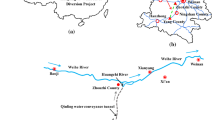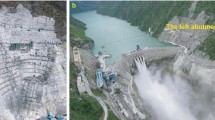Abstract
During the construction of the Hanjiang-to-Weihe River Diversion Project, frequent extremely intense rockbursts posed a serious threat to the safety of personnel and equipment. A microseismic (MS) monitoring system, which can effectively predict rockbursts, was established to monitor the sprouting and propagation of microcracks within the rock mass surrounding the tunnel in real time. First, the MS activity characteristics of the first excavated section (K33 + 870 ~ K37 + 011) and the second excavated section (K39 + 596 ~ K41 + 602) in the south Qinling section were compared under different surrounding rock classifications. Then, the time distribution characteristics of MS events from May 14 to June 14, 2020 were analyzed in detail, focusing on the MS event energy and spatial distribution of the first extremely intense rockburst. In addition, the effects of the daily excavation distance and excavation speed on the characteristics of extremely intense rockburst and MS activity were explored. Finally, the waveform and time–frequency characteristics of rockbursts with different intensities in the different surrounding rock classifications are discussed. According to the characteristics of the time–frequency, the extremely intense rockbursts in the classification I surrounding rock are divided mainly into low-frequency sustained type, low-frequency discontinuity type, and high-frequency discontinuity type, and the extremely intense rockbursts in the classification II surrounding rock are divided mainly into high-frequency discontinuity type and low-frequency discontinuity type. The study results are of great significance for improving the excavation efficiency and rockburst prediction accuracy in deep-buried tunnels with frequent rockbursts.


















Similar content being viewed by others
Data availability
The data that support the findings of this study are available from the corresponding author upon reasonable request.
References
Alcott JM, Kaiser PK, Simser BP (1998) Use of microseismic source parameters for rockburst hazard assessment. Pure Appl Geophys 153:41–65. https://doi.org/10.1007/s000240050184
Arora SK, Willy YA, Srinivasan C, Benady S (2001) Local seismicity due to rockbursts and near-field attenuation of ground motion in the Kolar gold mining region, India. Int J Rock Mech Min Sci 38:711–719. https://doi.org/10.1016/S1365-1609(00)00076-9
Chen B, Feng X, Ming H, Zhou H, Xiao Y (2012) Evolution law and mechanism of rockburst in deep tunnel: time delayed rockburst. Chin J Rock Mech Eng 31:561–569
Feng X, Yu Y, Feng G, Xiao Y, Chen B, Jiang Q (2016) Fractal behaviour of the microseismic energy associated with immediate rockbursts in deep, hard rock tunnels. Tunn Undergr Space Technol 51:98–107. https://doi.org/10.1016/j.tust.2015.10.002
Feng G, Feng X, Xiao Y, Yao Z, Hu L, Niu W, Li T (2019) Characteristic microseismicity during the development process of intermittent rockburst in a deep railway tunnel. Int J Rock Mech Min Sci 124:104135. https://doi.org/10.1016/j.ijrmms.2019.104135
Feng G, Chen B, Xiao Y, Jiang Q, Li P, Zheng H, Zhang W (2022) Microseismic characteristics of rockburst development in deep TBM tunnels with alternating soft–hard strata and application to rockburst warning: a case study of the Neelum–Jhelum hydropower project. Tunn Undergr Space Technol 122:104398. https://doi.org/10.1016/j.tust.2022.104398
Fujii Y, Ishijima Y, Deguchi G (1997) Prediction of coal face rockbursts and microseismicity in deep longwall coal mining. Int J Rock Mech Min Sci 34:85–96. https://doi.org/10.1016/S1365-1609(97)80035-4
Guo H, Chen L, Zhu J, Sun Q, Xiao Y (2022) Application of borehole camera technology in the identification of an instantaneous strain-structural-plane slip rockburst. B Eng Geol Environ 81:186. https://doi.org/10.1007/s10064-022-02658-3
Gutenberg B, Richter CF (1944) Frequency of earthquakes in California*. Bull Seismol Soc Am 34:185–188. https://doi.org/10.1785/BSSA0340040185
Holub K, Rušajová J, Holečko J (2011) Particle velocity generated by rockburst during exploitation of the longwall and its impact on the workings. Int J Rock Mech Min Sci 48:942–949. https://doi.org/10.1016/j.ijrmms.2011.05.004
Hu L, Feng X, Xiao Y, Wang R, Feng G, Yao Z, Niu W, Zhang W (2020) Effects of structural planes on rockburst position with respect to tunnel cross-sections: a case study involving a railway tunnel in China. B Eng Geol Environ 79:1061–1081. https://doi.org/10.1007/s10064-019-01593-0
Kaiser PK, Tannant DD, McCreath DR (1996) Drift support in burst-prone ground. CIM Bull 89(998):131–138
Konicek P, Waclawik P (2018) Stress changes and seismicity monitoring of hard coal longwall mining in high rockburst risk areas. Tunn Undergr Space Technol 81:237–251. https://doi.org/10.1016/j.tust.2018.07.019
Konicek P, Soucek K, Stas L, Singh R (2013) Long-hole destress blasting for rockburst control during deep underground coal mining. Int J Rock Mech Min Sci 61:141–153. https://doi.org/10.1016/j.ijrmms.2013.02.001
Lee SM, Park BS, Lee SW (2004) Analysis of rockbursts that have occurred in a waterway tunnel in Korea. Int J Rock Mech Min Sci 41:911–916. https://doi.org/10.1016/j.ijrmms.2004.03.157
Leveille P, Sepehri M, Apel DB (2017) Rockbursting potential of kimberlite: a case study of Diavik diamond mine. Rock Mech Rock Eng 50:3223–3231. https://doi.org/10.1007/s00603-017-1294-z
Li J, Tang S, Weng F, Li K, Yao H, He Q (2023b) Waveform recognition and process interpretation of microseismic monitoring based on an improved LeNet5 convolutional neural network. J Cent South Univ 30:904–918. https://doi.org/10.1007/s11771-023-5254-3
Li J, Tang S, Li K, Zhang S, Tang L, Cao L, Ji F (2022) Automatic recognition and classification of microseismic waveforms based on computer vision. Tunn Undergr Space Technol 121:104327. https://doi.org/10.1016/j.tust.2021.104327
Li J, Li K, Tang S (2023a) Automatic arrival-time picking of P- and S-waves of microseismic events based on object detection and CNN. Soil Dyn Earthq Eng 164:107560. https://doi.org/10.1016/j.soildyn.2022.107560
Liu F, Ca T, Ma T, Tang L (2019) Characterizing rockbursts along a structural plane in a tunnel of the hanjiang-to-weihe river diversion project by microseismic monitoring. Rock Mech Rock Eng 52:1835–1856. https://doi.org/10.1007/s00603-018-1649-0
Liu Q, Wu J, Zhang X, Tang L, Bi C, Li W, Xu J (2020) Microseismic monitoring to characterize structure-type rockbursts: a case study of a TBM-excavated tunnel. Rock Mech Rock Eng 53:2995–3013. https://doi.org/10.1007/s00603-020-02111-5
Ma TH, Tang CA, Tang LX, Zhang WD, Wang L (2015) Rockburst characteristics and microseismic monitoring of deep-buried tunnels for Jinping II Hydropower Station. Tunn Undergr Space Technol 49:345–368. https://doi.org/10.1016/j.tust.2015.04.016
Ma T, Tang C, Tang S, Kuang L, Yu Q, Kong D, Zhu X (2018) Rockburst mechanism and prediction based on microseismic monitoring. Int J Rock Mech Min Sci 110:177–188. https://doi.org/10.1016/j.ijrmms.2018.07.016
Ma C, Li T, Zhang H (2020) Microseismic and precursor analysis of high-stress hazards in tunnels: a case comparison of rockburst and fall of ground. Eng Geol 265:105435. https://doi.org/10.1016/j.enggeo.2019.105435
Ma C, Zhang H, Lu X, Ji X, Li T, Fang Y, Yan W, Ran X (2023) A novel microseismic classification model based on bimodal neurons in an artificial neural network. Tunn Undergr Space Technol 131:104791. https://doi.org/10.1016/j.tust.2022.104791
Malan DF, Napier JAL (2018) Rockburst support in shallow-dipping tabular stopes at great depth. Int J Rock Mech Min Sci 112:302–312. https://doi.org/10.1016/j.ijrmms.2018.10.026
Oppenheim AV, Schafer RW, Buck JR (1989) Discrete-time signal processing. Prentice-Hall, Englewood Cliffs
Pacheco JF, Scholz CH, Sykes LR (1992) Changes in frequency–size relationship from small to large earthquakes. Nature 355:71–73. https://doi.org/10.1038/355071a0
Poplawski RF (1997) Seismic parameters and rockburst hazard at Mt Charlotte mine. Int J Rock Mech Min Sci 34:1213–1228. https://doi.org/10.1016/S1365-1609(97)80072-X
Potvin Y, Hudyma M, Jewell RJ (2000) Rockburst and seismic activity in underground Australian mines—an introduction to a new research project. ISRM International Symposium:ISRM-IS-2000-2552.
Sepehri M, Apel DB, Adeeb S, Leveille P, Hall RA (2020) Evaluation of mining-induced energy and rockburst prediction at a diamond mine in Canada using a full 3D elastoplastic finite element model. Eng Geol 266:105457. https://doi.org/10.1016/j.enggeo.2019.105457
Srinivasan C, Arora SK, Benady S (1999) Precursory monitoring of impending rockbursts in Kolar gold mines from microseismic emissions at deeper levels. Int J Rock Mech Min Sci 36:941–948. https://doi.org/10.1016/S0148-9062(99)00048-0
Stewart RA, Reimold WU, Charlesworth EG, Ortlepp WD (2001) The nature of a deformation zone and fault rock related to a recent rockburst at Western Deep Levels Gold Mine, Witwatersrand Basin, South Africa. Tectonophysics 337:173–190. https://doi.org/10.1016/S0040-1951(01)00028-2
Stockwell RG, Mansinha L, Lowe RP (1996) Localization of the complex spectrum: the S transform. IEEE Trans Signal Process 44:998–1001. https://doi.org/10.1109/78.492555
Tang C, Wang J, Zhang J (2010) Preliminary engineering application of microseismic monitoring technique to rockburst prediction in tunneling of Jinping II project. J Rock Mech Geotech Eng 2:193–208. https://doi.org/10.3724/SP.J.1235.2010.00193
Tang S, Wang J, Tang C (2021) Identification of microseismic events in rock engineering by a convolutional neural network combined with an attention mechanism. Rock Mech Rock Eng 54:47–69. https://doi.org/10.1007/s00603-020-02259-0
Wang Y, Ca T, Tang L, Zhang S, Li L, Li Y, Duan W (2022) Microseismicity characteristics before and after a rockburst and mechanisms of intermittent rockbursts in a water diversion tunnel. Rock Mech Rock Eng 55:341–361. https://doi.org/10.1007/s00603-021-02666-x
Wang JX, Tang SB, Heap MJ, Tang CA, Tang LX (2021) An auto-detection network to provide an automated real-time early warning of rock engineering hazards using microseismic monitoring. Int J Rock Mech Min Sci 140:104685. https://doi.org/10.1016/j.ijrmms.2021.104685
Xu NW, Li TB, Dai F, Zhang R, Tang CA, Tang LX (2016) Microseismic monitoring of strainburst activities in deep tunnels at the Jinping II hydropower station, China. Rock Mech Rock Eng 49:981–1000. https://doi.org/10.1007/s00603-015-0784-0
Xue R, Liang Z, Xu N, Dong L (2020) Rockburst prediction and stability analysis of the access tunnel in the main powerhouse of a hydropower station based on microseismic monitoring. Int J Rock Mech Min Sci 126:104174. https://doi.org/10.1016/j.ijrmms.2019.104174
Zhang S, Ma T, Ca T, Jia P, Wang Y (2020) Microseismic monitoring and experimental study on mechanism of delayed rockburst in deep-buried tunnels. Rock Mech Rock Eng 53:2771–2788. https://doi.org/10.1007/s00603-020-02069-4
Zhang H, Ma C, Jiang Y, Li T, Pazzi V, Casagli N (2021a) Integrated processing method for microseismic signal based on deep neural network. Geophys J Int 226:2145–2157. https://doi.org/10.1093/gji/ggab099
Zhang H, Zeng J, Ma J, Fang Y, Ma C, Yao Z, Chen Z (2021b) Time series prediction of microseismic multi-parameter related to rockburst based on deep learning. Rock Mech Rock Eng 54:6299–6321. https://doi.org/10.1007/s00603-021-02614-9
Acknowledgements
This study was financially supported by the National Natural Science Foundation of China (Grant Nos. 51874065 and U1903112).
Author information
Authors and Affiliations
Contributions
Author Statement I would like to declare, on behalf of my co-authors, that the work submitted is original and has not been published previously, nor is it considered to be published elsewhere, either in whole or in part. All the listed authors have approved the enclosed manuscript. The contributions of all authors are listed below: Jiaming Li wrote the manuscript. Shibin Tang provided suggestions for the research method and revised the article completely. Liexian Tang and Chun Zhu processes the basic data. Zongzu Liu, Liang Zhao, Dong Yang and Lele Ma were mainly responsible for collecting and organizing in-situ testing and helping us to establish the monitoring system in the tunnel.
Corresponding author
Ethics declarations
Conflict of interest
The authors declare that they have no conflicts of interest.
Additional information
Publisher's Note
Springer Nature remains neutral with regard to jurisdictional claims in published maps and institutional affiliations.
Supplementary Information
Below is the link to the electronic supplementary material.
Rights and permissions
Springer Nature or its licensor (e.g. a society or other partner) holds exclusive rights to this article under a publishing agreement with the author(s) or other rightsholder(s); author self-archiving of the accepted manuscript version of this article is solely governed by the terms of such publishing agreement and applicable law.
About this article
Cite this article
Li, J., Tang, S., Tang, L. et al. Study on the characteristics of rockbursts in deep-buried tunnels based on microseismic monitoring. Environ Earth Sci 82, 357 (2023). https://doi.org/10.1007/s12665-023-11039-2
Received:
Accepted:
Published:
DOI: https://doi.org/10.1007/s12665-023-11039-2




